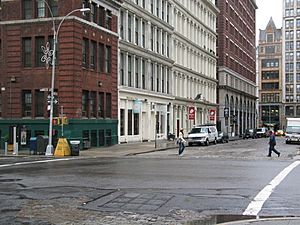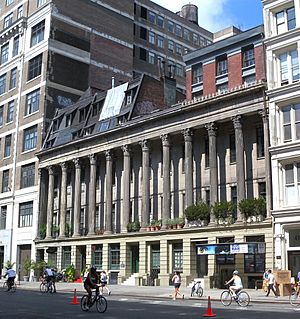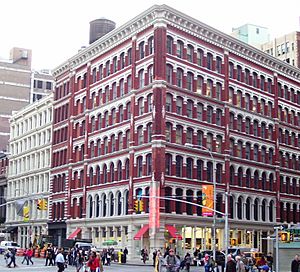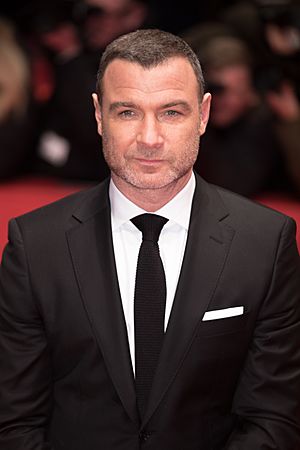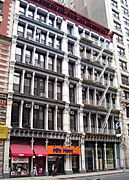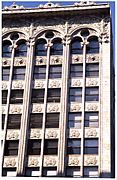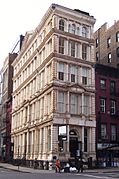NoHo, Manhattan facts for kids
NoHo is a cool neighborhood in Lower Manhattan, New York City. Its name is short for North of Houston Street. This helps people tell it apart from SoHo, which is South of Houston Street. NoHo is mostly a place where people live. It's located between Mercer Street to the west and the Bowery to the east. It stretches from East 9th Street in the north down to East Houston Street in the south.
Most of NoHo, with its 125 buildings, has been named a historic district by the New York City Landmarks Preservation Commission. This means the buildings and area are protected because they are important to history. There are two parts: the NoHo Historic District and the NoHo East Historic District, which was created in 2003.
Contents
History of NoHo
In 1748, a doctor from Switzerland named Jacob Sperry started the city's first botanical garden here. A botanical garden is a special park where different kinds of plants are grown and studied. At that time, this area was about a mile north of the main city. It was a nice place for people from downtown to visit for a vacation.
By 1804, a very rich man named John Jacob Astor bought the land from Sperry. He then rented it to Joseph Delacroix. Delacroix built a country resort called Vauxhall Gardens on the land. A country resort is a place where people go to relax and have fun outside the city. These gardens used to be in a different part of the city, further south.
Becoming a Fancy Neighborhood
NoHo quickly became a popular place for wealthy families. Streets like Bond, Bleecker, and Great Jones Streets grew very fast. It became too expensive to build houses on these streets. These were some of the most exclusive streets in the city. Famous people like Mayor Philip Hone lived there.
In 1826, after Delacroix's rental agreement ended, Astor turned the area into a fancy neighborhood. He created Lafayette Street right through the middle. This street was named by the Marquis de Lafayette in July 1825.
Rich New Yorkers, including the Astor family, built large mansions along Lafayette Street. Astor also built the Astor Library in the eastern part of the neighborhood. This was a gift to the city. An architect named Alexander Jackson Davis designed beautiful row houses called LaGrange Terrace. These are now known as Colonnade Row. They were built in 1833.
The area became a very fashionable place for upper-class families to live. When Lafayette Street opened in the 1820s, it quickly became one of New York's most stylish streets. This made the Vauxhall Gardens easy to reach for people living on nearby Broadway and the Bowery. Famous families like the Astor family and the Vanderbilt family lived in these houses. Writers like Washington Irving, Charles Dickens, and William Makepeace Thackeray also lived here. Even U.S. President John Tyler got married in one of these houses!
Changes Over Time
In the summer of 1838, the owners of the Vauxhall Gardens opened a saloon. This was a place for staging vaudeville comic operas. Vaudeville was a type of entertainment with different acts like music, comedy, and dancing. Later, theater managers added more shows to attract more people.
By 1850, the area started to change. Noisier crowds from the Bowery began to scare away the upper-class residents. Fewer people came to Vauxhall Gardens. The theater buildings were torn down in 1855, and the gardens closed for good in 1859.
Even so, some wealthy New Yorkers stayed until the end of the 1800s. The writer William Cullen Bryant and the inventor Isaac Singer lived in the neighborhood in the 1880s. But by the 1900s, many warehouses and factories moved into the area. The rich families moved to other places like Murray Hill, and NoHo became less fancy.
By the 1880s, the neighborhood was mainly a manufacturing area. This was especially true around Bond Street. New buildings called "loft" buildings were built. These were made of terra cotta and brick. Construction of these buildings continued into the 1890s. They were often built in the Greek Revival style, which looked back to the grand mansions that used to be there. Many of the old, fancy buildings were torn down. For example, in 1902, five mansions on Colonnade Row were demolished to make way for a part of the Wanamaker's Department Store. However, most of the mansions on Bond Street lasted until the 1930s.

Not all of NoHo was built for the very rich. Two old Federal architecture-style row houses on Bleecker Street were once home to the National Florence Crittenton Mission. This organization helped women who needed support. Today, the entrance at 21 Bleecker Street still has the words "Florence Night Mission." This mission was started in 1883 by a kind person named Charles N. Crittenton.
That same block of Bleecker Street is also home to the Margaret Sanger Health Center and the Catholic Sheen Center. Margaret Sanger Square is now located at the intersection with Mott Street.
Artists Move In
After World War II, many factories and manufacturing companies left New York City. By the 1950s, artists and small theater groups started renting these empty spaces. These artists had to work hard to get permission to live and work in these "loft" spaces. By 1960, more artists lived in these lofts than businesses.
Some famous artists who lived here included Robert Mapplethorpe, Chuck Close, Jean-Michel Basquiat, and Andy Warhol. The neighborhood started to become popular again in the late 1960s and 1970s. As artists moved into the lofts in the 1970s and 1980s, the name NoHo started to be used. This helped people tell it apart from SoHo. Before this, the whole area, including NoHo, SoHo, and parts of Tribeca, was known as the "warehouse district." The growth of art in the 1970s and efforts to preserve old buildings in the 1990s and 2000s also helped make the area lively again.
Preserving NoHo's History
In 1999, the New York City Landmarks Preservation Commission officially named NoHo a city historic district. This means that the buildings and the area are protected because they are important to the city's history.
The report about this designation said that the NoHo Historic District has about 125 buildings. These buildings show what New York City was like from the 1850s to the 1910s. During this time, NoHo was a major center for selling clothes and other goods. Famous architects designed beautiful store and loft buildings. These buildings were made of materials like marble, cast iron, limestone, brick, and terracotta. They created impressive streets where shoppers could look at window displays and buy things. The district also has older houses from the 1800s, and other buildings from the 1900s. All these buildings show how the area changed over time.
The NoHo Historic District was made even bigger in 2008. Also, another historic district, the NoHo East Historic District, was created in 2003. These protections happened because many local groups worked hard to support them. Groups like the Greenwich Village Society for Historic Preservation and Historic Districts Council helped a lot. Together, these districts form a large area of protected buildings across 21 city blocks.
Most of the buildings in the 2008 expansion were built between the 1860s and early 1900s. This was when NoHo became one of the city's main business and factory areas. By the late 1800s, larger commercial loft buildings in the Greek Revival style became very common.
The Merchant's House Museum, located at 29 East Fourth Street, is a special historic building. It's just outside the main Historic District. It's also a National Historic Landmark, which means it's important to the whole country. This house was built in 1832. Both the inside and outside have been restored to look like they did in the mid-1800s. This is how merchant Seabury Tredwell and his family lived.
Even though the old house is fragile, in April 2014, the New York City Landmarks Preservation Commission allowed an eight-story hotel to be built right next door. Many people who wanted to protect the house, like City Councilwoman Rosie Mendez and the Greenwich Village Society for Historic Preservation, fought against the hotel for years. They were worried about the old Merchant's House. But the Commission approved it anyway, even with concerns from engineers and architects.
NoHo Today: A Changing Neighborhood
In the 2000s and 2010s, NoHo and its neighbor, SoHo, have changed a lot. This change is called gentrification. It means that a neighborhood becomes more popular and expensive. Since NoHo has many loft apartments, it has become one of the most expensive and desired neighborhoods in Manhattan. Its small size and central location also make it highly sought after, keeping prices high. For example, in 2014, a one-bedroom loft could cost around $4,000 per month to rent.
Cool Places to See in NoHo
Some important landmarks in the NoHo Historic District include the Astor Library, the Bouwerie Lane Theater, the Bayard-Condict Building, and the De Vinne Press Building. Two New York City Subway stations, Astor Place and Bleecker Street, are also protected as landmarks.
The only remaining part of the fancy 19th-century era is half of the original Colonnade Row, which is also a landmark. The Gene Frankel Theater, which started in 1949, is in the landmarked building at 24 Bond Street, built in 1893.
Across from Colonnade Row, you can find The Public Theater.
The easternmost block of Bleecker Street still has the last remaining Federal architecture-style row houses. Two of these were once home to the Florence Night Mission, which helped women in need. (The entrance at 21 Bleecker Street still has the words in its flooring.)
Famous People Who Lived in NoHo
Many interesting people have lived in NoHo, including:
- Dianna Agron (born 1986), actress
- Jean-Michel Basquiat (1960–1988), artist
- Jessica Chastain (born 1977), actress and producer
- Chuck Close (1940–2021), painter and photographer
- Sheryl Crow (born 1962), musician and actress
- Peter Cunningham, photographer
- Hanna Eshel (1926–2023), sculptor
- Gigi Hadid (born 1995), model
- Glen Hansard lived at 21 Bleecker Street
- Jonah Hill (born 1983), actor and director
- Lauren Hutton (born 1943), model and actress
- Zach Iscol (born 1978), US Marine Corps veteran and entrepreneur
- Dua Lipa (born 1995), singer and songwriter (lived at 21 Bleecker Street, 2019–2020)
- Robert Mapplethorpe (1946–1989), photographer
- Miles McMillan (born 1989), model and painter
- Cynthia Nixon (born 1966), actress and activist
- Glenn O'Brien (1947–2017), writer
- Zachary Quinto (born 1977), actor and film producer
- Emily Ratajkowski (born 1991), model and actress
- Robert Rauschenberg (1925–2008), painter
- Keith Richards (born 1943), musician
- Suze Rotolo (1943–2011), artist
- Liev Schreiber (born 1967), actor and director
- Stéphane Sednaoui (born 1963), director and photographer
- Alexander Soros (born 1985), philanthropist
- Britney Spears (born 1981), singer and dancer
- Frank Stella (born 1936), painter and sculptor
- Kristen Stewart (born 1990), actress and filmmaker
- Jean-Claude van Itallie (1936–2021), playwright (lived at 21 Bleecker Street)
- Gernot Wagner (born 1980), climate economist (lived at 21 Bleecker Street)
- Cameron Winklevoss (born 1981), Olympic rower and investor
Gallery
-
Facade of Louis Sullivan's Bayard–Condict Building (built 1897–99) at 65 Bleecker Street between Broadway and Lafayette Street
-
The Bouwerie Lane Theatre's Bowery facade
See also
 In Spanish: NoHo para niños
In Spanish: NoHo para niños


